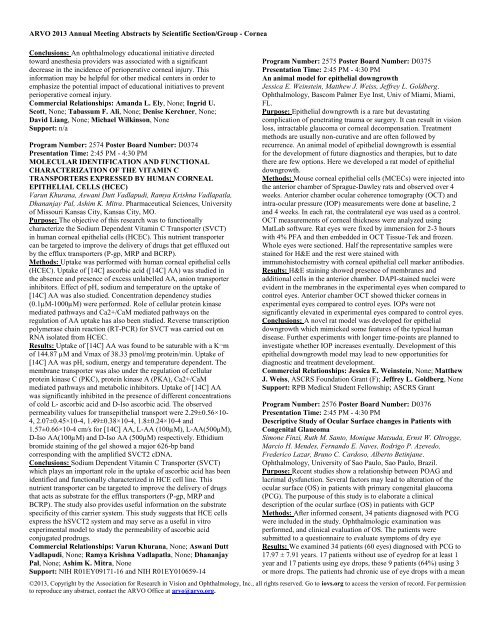Cornea - ARVO
Cornea - ARVO
Cornea - ARVO
Create successful ePaper yourself
Turn your PDF publications into a flip-book with our unique Google optimized e-Paper software.
<strong>ARVO</strong> 2013 Annual Meeting Abstracts by Scientific Section/Group - <strong>Cornea</strong>Conclusions: An ophthalmology educational initiative directedtoward anesthesia providers was associated with a significantdecrease in the incidence of perioperative corneal injury. Thisinformation may be helpful for other medical centers in order toemphasize the potential impact of educational initiatives to preventperioperative corneal injury.Commercial Relationships: Amanda L. Ely, None; Ingrid U.Scott, None; Tabassum F. Ali, None; Denise Kerchner, None;David Liang, None; Michael Wilkinson, NoneSupport: n/aProgram Number: 2574 Poster Board Number: D0374Presentation Time: 2:45 PM - 4:30 PMMOLECULAR IDENTIFICATION AND FUNCTIONALCHARACTERIZATION OF THE VITAMIN CTRANSPORTERS EXPRESSED BY HUMAN CORNEALEPITHELIAL CELLS (HCEC)Varun Khurana, Aswani Dutt Vadlapudi, Ramya Krishna Vadlapatla,Dhananjay Pal, Ashim K. Mitra. Pharmaceutical Sciences, Universityof Missouri Kansas City, Kansas City, MO.Purpose: The objective of this research was to functionallycharacterize the Sodium Dependent Vitamin C Transporter (SVCT)in human corneal epithelial cells (HCEC). This nutrient transportercan be targeted to improve the delivery of drugs that get effluxed outby the efflux transporters (P-gp, MRP and BCRP).Methods: Uptake was performed with human corneal epithelial cells(HCEC). Uptake of [14C] ascorbic acid ([14C] AA) was studied inthe absence and presence of excess unlabelled AA, anion transporterinhibitors. Effect of pH, sodium and temperature on the uptake of[14C] AA was also studied. Concentration dependency studies(0.1µM-1000µM) were performed. Role of cellular protein kinasemediated pathways and Ca2+/CaM mediated pathways on theregulation of AA uptake has also been studied. Reverse transcriptionpolymerase chain reaction (RT-PCR) for SVCT was carried out onRNA isolated from HCEC.Results: Uptake of [14C] AA was found to be saturable with a K¬mof 144.87 µM and Vmax of 38.33 pmol/mg protein/min. Uptake of[14C] AA was pH, sodium, energy and temperature dependent. Themembrane transporter was also under the regulation of cellularprotein kinase C (PKC), protein kinase A (PKA), Ca2+/CaMmediated pathways and metabolic inhibitors. Uptake of [14C] AAwas significantly inhibited in the presence of different concentrationsof cold L- ascorbic acid and D-Iso ascorbic acid. The observedpermeability values for transepithelial transport were 2.29±0.56×10-4, 2.07±0.45×10-4, 1.49±0.38×10-4, 1.8±0.24×10-4 and1.57±0.66×10-4 cm/s for [14C] AA, L-AA (100µM), L-AA(500µM),D-Iso AA(100µM) and D-Iso AA (500µM) respectively. Ethidiumbromide staining of the gel showed a major 626-bp bandcorresponding with the amplified SVCT2 cDNA.Conclusions: Sodium Dependent Vitamin C Transporter (SVCT)which plays an important role in the uptake of ascorbic acid has beenidentified and functionally characterized in HCE cell line. Thisnutrient transporter can be targeted to improve the delivery of drugsthat acts as substrate for the efflux transporters (P-gp, MRP andBCRP). The study also provides useful information on the substratespecificity of this carrier system. This study suggests that HCE cellsexpress the hSVCT2 system and may serve as a useful in vitroexperimental model to study the permeability of ascorbic acidconjugated prodrugs.Commercial Relationships: Varun Khurana, None; Aswani DuttVadlapudi, None; Ramya Krishna Vadlapatla, None; DhananjayPal, None; Ashim K. Mitra, NoneSupport: NIH R01EY09171-16 and NIH R01EY010659-14Program Number: 2575 Poster Board Number: D0375Presentation Time: 2:45 PM - 4:30 PMAn animal model for epithelial downgrowthJessica E. Weinstein, Matthew J. Weiss, Jeffrey L. Goldberg.Ophthalmology, Bascom Palmer Eye Inst, Univ of Miami, Miami,FL.Purpose: Epithelial downgrowth is a rare but devastatingcomplication of penetrating trauma or surgery. It can result in visionloss, intractable glaucoma or corneal decompensation. Treatmentmethods are usually non-curative and are often followed byrecurrence. An animal model of epithelial downgrowth is essentialfor the development of future diagnostics and therapies, but to datethere are few options. Here we developed a rat model of epithelialdowngrowth.Methods: Mouse corneal epithelial cells (MCECs) were injected intothe anterior chamber of Sprague-Dawley rats and observed over 4weeks. Anterior chamber ocular coherence tomography (OCT) andintra-ocular pressure (IOP) measurements were done at baseline, 2and 4 weeks. In each rat, the contralateral eye was used as a control.OCT measurements of corneal thickness were analyzed usingMatLab software. Rat eyes were fixed by immersion for 2-3 hourswith 4% PFA and then embedded in OCT Tissue-Tek and frozen.Whole eyes were sectioned. Half the representative samples werestained for H&E and the rest were stained withimmunohistochemistry with corneal epithelial cell marker antibodies.Results: H&E staining showed presence of membranes andadditional cells in the anterior chamber. DAPI-stained nuclei wereevident in the membranes in the experimental eyes when compared tocontrol eyes. Anterior chamber OCT showed thicker corneas inexperimental eyes compared to control eyes. IOPs were notsignificantly elevated in experimental eyes compared to control eyes.Conclusions: A novel rat model was developed for epithelialdowngrowth which mimicked some features of the typical humandisease. Further experiments with longer time-points are planned toinvestigate whether IOP increases eventually. Development of thisepithelial downgrowth model may lead to new opportunities fordiagnostic and treatment development.Commercial Relationships: Jessica E. Weinstein, None; MatthewJ. Weiss, ASCRS Foundation Grant (F); Jeffrey L. Goldberg, NoneSupport: RPB Medical Student Fellowship; ASCRS GrantProgram Number: 2576 Poster Board Number: D0376Presentation Time: 2:45 PM - 4:30 PMDescriptive Study of Ocular Surface changes in Patients withCongenital GlaucomaSimone Finzi, Ruth M. Santo, Monique Matsuda, Ernst W. Oltrogge,Marcio H. Mendes, Fernando E. Naves, Rodrigo P. Azevedo,Frederico Lazar, Bruno C. Cardoso, Alberto Betinjane.Ophthalmology, University of Sao Paulo, Sao Paulo, Brazil.Purpose: Recent studies show a relationship between POAG andlacrimal dysfunction. Several factors may lead to alteration of theocular surface (OS) in patients with primary congenital glaucoma(PCG). The purpouse of this study is to elaborate a clinicaldescription of the ocular surface (OS) in patients with GCPMethods: After informed consent, 34 patients diagnosed with PCGwere included in the study. Ophthalmologic examination wasperformed, and clinical evaluation of OS. The patients weresubmitted to a questionnaire to evaluate symptoms of dry eyeResults: We examined 34 patients (60 eyes) diagnosed with PCG to17.97 ± 7.91 years. 17 patients without use of eyedrop for at least 1year and 17 patients using eye drops, these 9 patients (64%) using 3or more drops. The patients had chronic use of eye drops with a mean©2013, Copyright by the Association for Research in Vision and Ophthalmology, Inc., all rights reserved. Go to iovs.org to access the version of record. For permissionto reproduce any abstract, contact the <strong>ARVO</strong> Office at arvo@arvo.org.
















